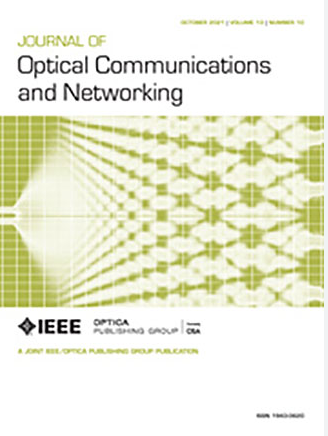利用点对多点相干可插拔收发器优化设计无马蹄形和刺状滤波器网络
IF 4
2区 计算机科学
Q1 COMPUTER SCIENCE, HARDWARE & ARCHITECTURE
引用次数: 0
摘要
运营商需要先进的网络架构和解决方案来有效满足城域网和接入网的容量需求。马蹄形拓扑以及类似的拓扑结构通常用于城域汇聚网段,因为它与这些网络中存在的集线器-辐条流量模式兼容,并可提供生存能力。无滤波器架构可以用无源器件取代有源元件,从而提高成本效益。此外,通过数字子载波多路复用(DSCM)支持基于相干的点对多点收发器,还能节省更多成本。值得注意的是,电信网络拓扑结构经常会发生变化,以容纳更多的末端(叶片)节点,用尖刺或小树和短树扩展原来的马蹄形网络。本文针对这些类型的网络,建议结合使用利用 DSCM 的相干可插拔收发器,以保证集线器和叶节点之间的透明通信,同时采用不同的无滤波器节点架构,并选择性地部署放大器。此外,它还讨论了该架构的潜在优势,该架构采用了一个针对各种网络规模和场景的精确优化框架,其中考虑到了放大器的位置和可用的功率分配器/合路器/耦合器类型。结果表明,战略性地部署分插放大器和快递放大器,同时优化耦合器比率,可以有效满足设计要求,同时最大限度地减少所需的光放大器数量。本文章由计算机程序翻译,如有差异,请以英文原文为准。
Optimized design of horseshoe-and-spur filterless networks leveraging point-to-multipoint coherent pluggable transceivers
Cutting-edge network architectures and solutions are needed to empower operators to address capacity demands in metro and access networks efficiently. The horseshoe topology, along with similar topologies, is commonly employed in metro-aggregation segments due to its compatibility with the hub-and-spoke traffic pattern present in these networks and the survivability that they can provide. A filterless architecture can enhance cost-effectiveness by replacing active elements with passive components. Moreover, supporting coherent-based point-to-multipoint transceivers—enabled by digital subcarrier multiplexing (DSCM)—can yield additional cost savings. It is noteworthy that telecommunication network topologies often evolve to accommodate more end (leaf) nodes, extending the original horseshoe with spurs or small and short trees. This paper targets these types of networks and proposes combining the utilization of coherent pluggable transceivers leveraging DSCM to guarantee transparent communication between the hub and leaf nodes while adopting different filterless node architectures with selective amplifier deployment. Moreover, it discusses the potential advantages of the architecture using an exact optimization framework tailored to various network sizes and scenarios, which accounts for the amplifiers’ placement and the available types of power splitters/combiners/couplers. The results demonstrate that strategically deploying add/drop and express amplifiers, along with optimizing coupler ratios, can effectively meet design requirements while minimizing the number of optical amplifiers required.
求助全文
通过发布文献求助,成功后即可免费获取论文全文。
去求助
来源期刊
CiteScore
9.40
自引率
16.00%
发文量
104
审稿时长
4 months
期刊介绍:
The scope of the Journal includes advances in the state-of-the-art of optical networking science, technology, and engineering. Both theoretical contributions (including new techniques, concepts, analyses, and economic studies) and practical contributions (including optical networking experiments, prototypes, and new applications) are encouraged. Subareas of interest include the architecture and design of optical networks, optical network survivability and security, software-defined optical networking, elastic optical networks, data and control plane advances, network management related innovation, and optical access networks. Enabling technologies and their applications are suitable topics only if the results are shown to directly impact optical networking beyond simple point-to-point networks.

 求助内容:
求助内容: 应助结果提醒方式:
应助结果提醒方式:


